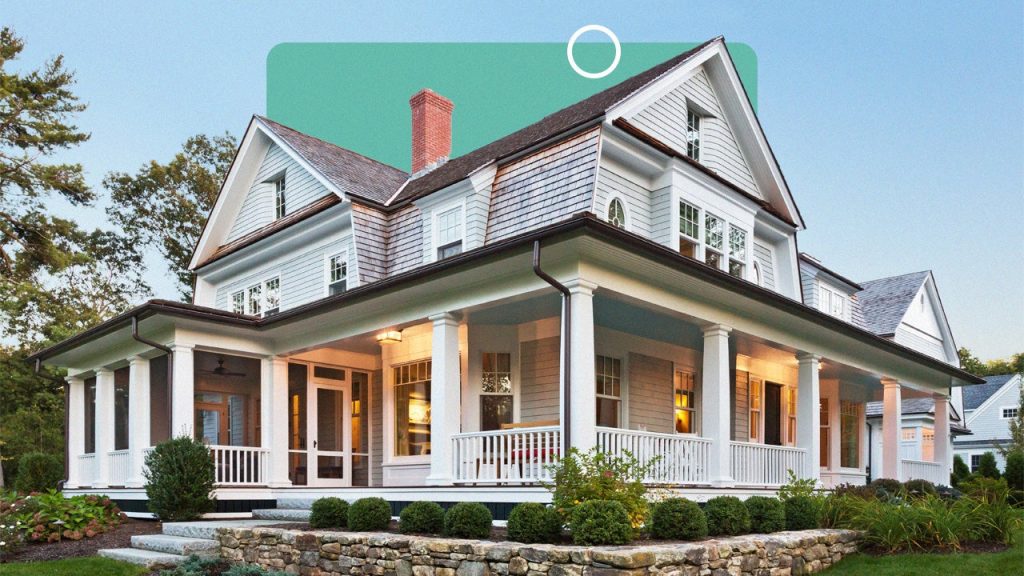Key takeaways
- While your home’s value is determined by many factors, some home improvements could help increase its worth.
- There are multiple ways to pay for upgrades, including cash-out refinancing, a home equity loan or home improvement loan.
- If you plan to sell your home, it’s important to determine not just how much improvements will cost, but also how much of that cost you’ll recoup.
The value of your home can increase or decrease due to any number of factors. Some variables out of your control — like how hot your local housing market is or isn’t. But others may be — namely, strategic upgrades to the premises.
Many home improvements can add a significant amount to the value of your home, enhancing your equity stake. While they won’t all recoup their full cost, they definitely will make the home more marketable — and of course, improve your quality of life while you still occupy it.
8 ways to increase the value of your home
There are a variety of ways to add value to your home. Some are simple and fast DIY jobs. Others require an upfront investment and the use of professionals.
1. Clean and declutter
To increase the value of your home, begin by decreasing the amount of stuff that’s inside it. Cleaning and decluttering are relatively inexpensive tasks, even in bigger homes. Professionally cleaning a four-bedroom home averages between $200 and $225, according to HomeAdvisor.
Of course, you could save money by doing the work yourself. Start by going through cabinets and closets and making donation piles. Then clean out drawers and other storage areas, making sure you’re not keeping anything you don’t need or want.
2. Add usable square footage
Homes are valued and priced by the livable square feet they contain, and the more livable square feet, the better, says Benjamin Ross, a Realtor and real estate investor based in Corpus Christi, Texas.
Adding a bathroom, a great room or another needed space to a home can increase function and add value. A separate in-law suite can also be a smart idea.“Most homes do not have this feature,” says Ross, “so adding one sets you apart from the competition when it is time to sell.”
3. Make your home more energy-efficient
Projects that lower utility bills can increase the value of your home. Installing a smart thermostat, for example, helps improve efficiency and save money, says Scott Ewald, director, brand and content marketing at Trane, an HVAC company.
“The right smart thermostat will allow a homeowner to control their home’s climate from anywhere, giving them the power to manage energy costs regardless of whether they are sitting on the couch or away on vacation,” says Ewald. “Such investments in home tech — particularly when connected to the HVAC, which is the largest mechanical system in the home — provides a strong selling point and highlights the home’s overall comfort, functionality, energy efficiency and convenience.”
It can cost between $175 to $1,000 to make this quick upgrade, according to HomeAdvisor, or an average of about $350. However, you could make that money back fairly quickly. A 2024 report from Green Wave Distribution, a heating-systems installer, found that homeowners can save over one-third of their energy bills via such simple steps as appropriate insulation, air sealing and thermostat settings. A combination of all three projects could cut your energy bills by nearly $234 annually.
Other ways to improve your home’s efficiency and value include replacing old, leaky windows, installing energy-efficient home appliances and adding insulation to your home.
4. Spruce it up with fresh paint
A fresh coat of paint can make even dated exteriors and interiors look fresh and new.
Begin by repainting any rooms with an “odd” color scheme, says Timothy Wiedman, a personal finance expert and home-flipper. For example, did you let your 11-year-old daughter paint her bedroom hot pink 10 years ago? If so, that’s a good place to start.
The cost of an interior painting project ranges between roughly $970 and $3,000, with a national average of $1,988, according to HomeAdvisor. Your exact painting budget will depend on room size. HomeAdvisor pegs painting a bathroom — usually the smallest room in the house — somewhere between $150 and $300, while a 330-square-foot living room might cost as much as $2,000. An exterior paint job, on the other hand, will cost much more, with prices ranging from $1,810 to $4,505 (the national average is just over $3,000).
If you just want to repaint a door or a single room, doing it yourself could cost you between $200 and $300. For bigger jobs, though — especially exterior ones — hiring a painter might be worth it, given that professionals can buy paint at wholesale prices, know what sort of finishes to use and are more adept at scaling ladders.
5. Work on your curb appeal
From power washing your driveway to mowing the lawn, improving curb appeal can make a big difference in your home’s value.
Upgrading your landscape can go an especially long way, says Joe Raboine, vice president of Design at Oldcastle APG, a manufacturer of exterior building products. Some ideas: a fresh walkway, shrubs, planters, mulching or even a new patio or outdoor kitchen.
6. Upgrade your exterior doors
Also in the vein of curb appeal, replacing an old front door can work wonders, says Wiedman. In the late ’90s, he and his wife replaced an old, ugly door with a solid mahogany door with a frosted, oval piece of lead glass. He stained the door himself to save money, and the result was “simply stunning.”
Don’t forget the garage doors, too, says Randy Oliver, president of Hollywood-Crawford Door Company. “The front of the home is the first thing you, your neighbors and prospective buyers will see,” says Oliver. “Garage doors often take up the most amount of space on the front of your home, so installing a modern glass panel door or a rustic wood door will dramatically improve your home’s appearance.”
These jobs offer one of the highest returns on investment among home renovations: nearly 200 percent for garage doors, and 188 percent for steel front doors, according to trade journal Remodeling by JLC.
7. Update your kitchen
Many buyers zero in on the kitchen as the central feature of a home, so if yours is outdated, it can ultimately affect how much you garner from a sale. Likewise, if you aren’t able to utilize your kitchen fully due to layout, space or other concerns, you won’t be maximizing the space.
This project, though, will require a lot of money, and you likely won’t get back every dollar you invest. Midrange or modest upgrades come close, though, and actually offer a better ROI than the most elaborate ones: A minor kitchen remodel with midrange appliances costs around $27,500, and adds about $26,400 of value when it’s time to sell, according to Remodeling.
If updating your entire kitchen is too big of an undertaking, even small changes could still have an impact — think coordinating appliances and installing modern hardware on your cabinets.
8. Stage your home
If you’re planning to list your home for sale, consider skipping cosmetic home improvements and go with a home staging service instead. Staging costs about $800 to $2,800 on average, according to HomeAdvisor, but the cost varies based on your needs and home.
Staging services range widely, from decluttering and depersonalization (for example, removing family photos or specific decor) to bringing in rented furnishings and repainting. Simply put, the more work involved to stage it, the more expensive the production will be. A real estate agent can help you determine what sort of staging would make the most impact on your home’s value.
Reasons to increase your home value
Your home is likely one of your largest assets, so increasing its value contributes to your overall net worth. Raising your home’s value has other benefits, as well, such as:
- More profit when you sell: A higher home value translates to higher asking price when you put the place on the market.
- More tappable home equity: If you need cash, you can borrow against your home’s equity — more so the more your home is worth.
- Some protection from market swings: If your home has a higher value, you might be able to guard against major dips in the housing market.
- No more mortgage insurance: If your home appraises for a higher value, it increases your equity stake — to a level that leads to the elimination of private mortgage insurance premiums.
- Aesthetics and function: Upgrades increase your enjoyment and use of your home.
$13,667
The average amount homeowners spent on home improvement in 2023
Source:
Angi
How to pay for home improvements to increase value
There are many ways to finance home improvements. According to the 2024 U.S. Houzz and Home Study, cash (from savings) continues to be the most common way to pay for renovation projects (used 83 percent of the time), followed at a distance by credit cards (37 percent) and secured loans (14 percent). For bigger budget projects, between $50,000 and $200,000, secured loans — like home equity loans or lines of credit — are used 23 percent of the time.
Personal loan
Personal loans allow you to borrow a fixed amount at a fixed interest rate. These loans are unsecured, meaning you don’t have to put your home or other property up as collateral. Many personal loan lenders allow you to borrow as much as $35,000 for home improvements — sometimes more, depending on your credit and other factors.
If you have good credit (which’ll ensure the best rate), and want to get funds relatively quickly, a personal loan can be the simplest, easiest way to go.
Home equity loan or HELOC
Home equity loans are similar to personal loans in that you receive a lump sum of cash at a fixed interest rate and fixed monthly payment. Home equity lines of credit, or HELOCs, work like credit cards — a revolving balance that you can draw on at different intervals — and come with variable rates.
Both borrowing options require you to put your home up as collateral to qualify. They carry lower interest rates than credit cards or personal loans, and the interest might be deductible if you use the money to make eligible home improvements.
These are good options for homeowners who’ve paid off much of their mortgage and so have a significant amount of equity to borrow against. And who need a significant amount, at least $25,000 or so, for their project.
0% APR credit card
A 0% APR credit card charges no interest on balances for a set period, often up to 18 months. Just remember: If you don’t pay your balance off by the time your zero-percent APR offer ends, your card’s interest rate will reset to a higher variable rate, costing you more.
This option can be ideal if you have a smaller-scale project in mind — one that you can pay off by the time the interest-free period ends. A credit card can also work well if you’re able to pay your contractor with it.
Cash-out refinance
A cash-out refinance involves swapping your old mortgage for a new larger one, and receiving the difference in ready money. The extra amount is based on the size of your home equity stake. The refinancing process is just as paperwork-heavy as taking out a mortgage, and you’ll need to pay closing costs.
The most elaborate and time-consuming method, a cash-out refi works best for big projects, and if you were thinking of refinancing anyway — perhaps because of a dip in interest rates since your original mortgage. It’s a good option for homeowners who own significant equity in their home, and who don’t mind continuing to pay off their mortgage for a few more years.
FAQ
-
Different renovations can have varying degrees of impact on your home’s value. Respected trade journal Remodeling’s “2024 Cost vs. Value Report” notes a range of ROIs from 23.9% (for a primary suite addition) to 193.9% (for replacing a garage door). Generally, you shouldn’t expect a dollar-for-dollar return on a renovation.
-
You can make some major upgrades to your home with a $100,000 budget. For example, you might be able to convert your attic into living space or add a standard bathroom, mudroom or sunroom. No matter what you decide to do to your home, you can stretch that $100,000 further by focusing on more affordable materials – think standard materials and finishes instead of custom choices.
-
Establish your goals. For example, is the renovation so you can enjoy the home for the foreseeable future, or are you aiming to increase the value and sell it in hopes of turning a profit? Then, create an outline of everything you want to accomplish, and get quotes from multiple contractors for the cost and timeline. You don’t have to go with the cheapest option; go with the one that is most reputable. Before you go too far down the path to starting the project, make a plan for what you’re going to do during the renovation. Will you be able to live there during the construction, or do your plans call for gutting the home? If you need to relocate for part of the project, it’s important to figure out how to minimize those short-term living costs.
-
It really depends how handy you are. You can paint your house yourself, and you can definitely clean without hiring a professional. Replacing doors is a little more complicated, but possible if you have the tools and experience. Adding new rooms, or upgrading your electrical, HVAC or plumbing systems is best left to professionals.
-
Cleaning and decluttering your house is essentially free, and can add a surprising amount to the value of your home. Painting interior rooms is also inexpensive, but can make it a lot easier to sell your home for a good price.
-
Opinion is divided on this question. It might be more comfortable to renovate your house in the spring and early summer, when you can work outside comfortably. However, contractors also tend to charge more at these times, so if you want the best possible prices it can be better to renovate over the winter.
Read the full article here










